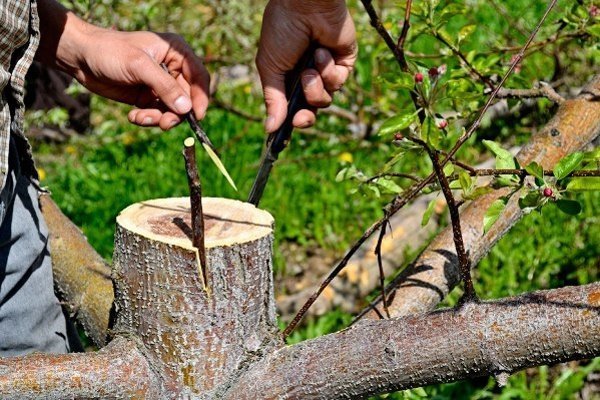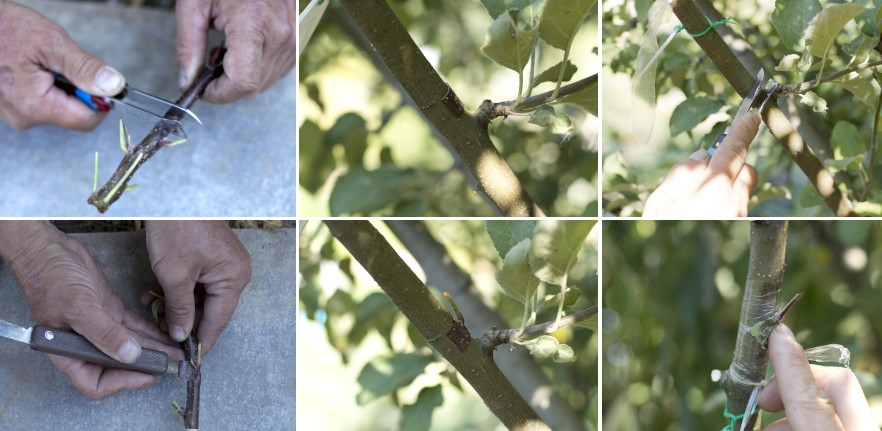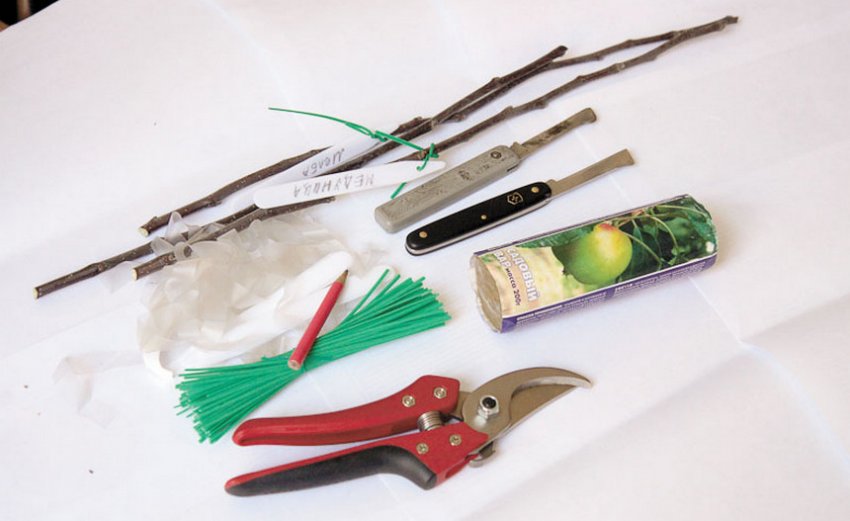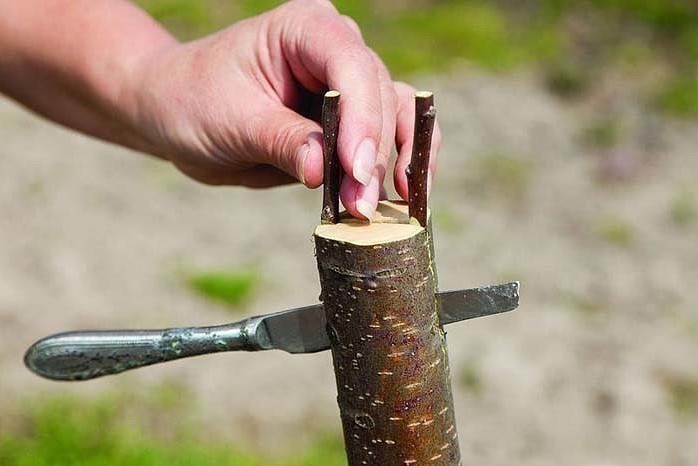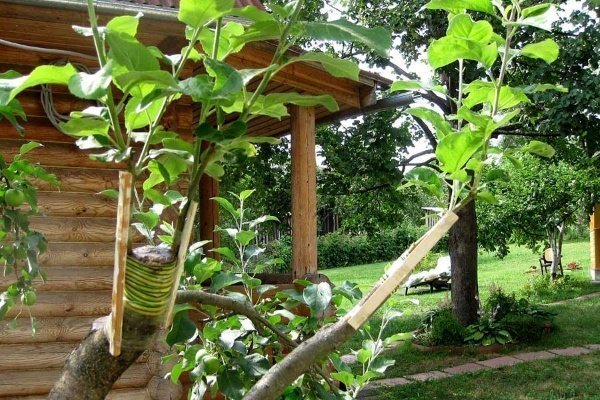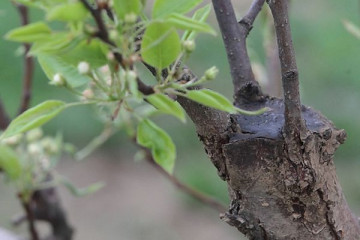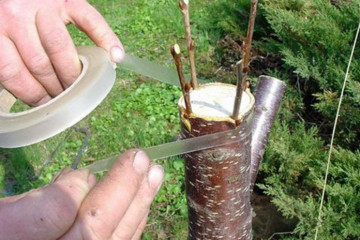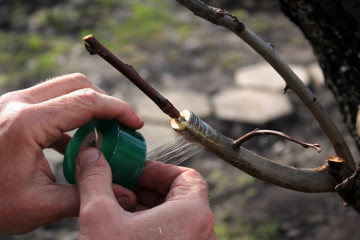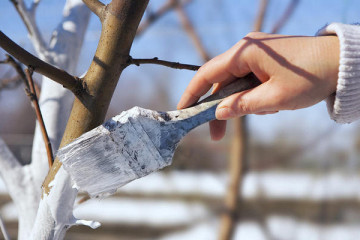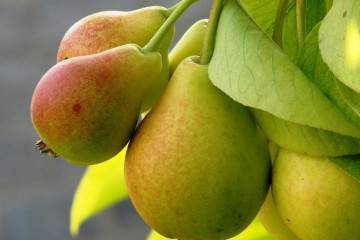How to plant an apple tree in summer and budding other fruit trees
Content:
- What grafting a tree and a gardener gives
- Terms of grafting apple trees
- Grafting methods for fruit trees
- How to tell if a tree is ready for grafting
- Required tools and materials
- Rootstock selection
- How to bud an apple and pear: a step-by-step description
- Safety engineering
- Apple and pear care after budding
- Possible mistakes of novice gardeners
- Useful Tips
Grafting apple trees is a rather difficult, and in some situations even a necessary type of restoration of fruit trees. The beginner gardener will not be able to cope with the task the first time. It is important to choose the right time for the manipulation, although many argue that the twig can be grafted almost at any time of the year. It is worth carefully following the recommendations regarding the process itself. But first you have to prepare the tools and all the necessary devices.
What grafting a tree and a gardener gives
There are several reasons why you have to plant an apple tree. Moreover, they are relevant in terms of efficiency both for the tree itself and for the gardener. What new opportunities does the vaccine provide:
- Increases harvest due to crown renewal. At the same time, a massive and well-developed root system of the tree is preserved.
- It becomes possible to get several varieties of apples from one tree. This significantly saves space on the site.
- If necessary, to improve the frost resistance of the apple variety, grafting can also be done. Then the tree will ensure the normal existence of a branch with fruits without any problems.
- In case of damage as a result of mechanical damage, part of the tree can be saved by grafting a branch. In addition, you will get a beautiful dwarf fruit tree.
Terms of grafting apple trees
There are many recommendations on how to plant an apple tree in the summer. But it turns out that this can be done all year round. But first, it is worth assessing the condition of the tree itself, weather conditions and climatic zone. Only then can the best time for the procedure be determined.
Features of vaccination in different regions
Russia has a huge length and many climatic zones. Moreover, each has its own characteristics and terms regarding the implementation of the vaccination procedure:
| Regions of Russia | Spring grafting | Summer | Autumn | Winter |
| Siberia, Ural and Karelia | When the ground thawed to a depth of 30 cm | First week of August | Not desirable | If weather conditions permit, this is the ideal time for the procedure. |
| Middle lane | April 15 to May 3 | July 25 to August 5 | 2 first weeks of September | Not desirable |
| Southern regions | Mid-early March | From the second half of July to mid-August | From the second decade of September to mid-October | Not desirable |
Grafting methods for fruit trees
There are several ways to graft fruit trees. Each has its own advantages and characteristics. Especially popular with gardeners:
- Budding.
- Grafting for the bark.
- Into the cleft.
- In the cut.
- Vaccination with a pipe.
- Bud and cuttings.
- Bridge inoculation.
By eye (budding)
Usually, budding of fruit trees is carried out in summer, although in the northern and southern regions it is still spring that is the preferred season. This option can be used by gardeners of all skill levels. Thanks to the simple technology, this method almost always guarantees 100% efficiency.
Bark grafting
This method is often used when several young branches of different varieties need to be grafted onto the stem of an old apple tree. Thus, you can save the old tree from complete destruction.
The features of grafting under the bark are as follows:
- It is necessary to make a correct cut of the trunk so that several branches remain for the normal functioning of the root system.
- Several cuts must be made vertically along the bark. The depth must be such that the wood is touched.
- With the back of the knife, at the place of the cuts, you need to slightly separate the bark from the wood.
- Make an oblique cut 4 cm long on the handle.
- Stick the scion into the prepared "holes" in the bark.
- In order for the branch of the cutting to be well fixed under the bark, it is worth wrapping the trunk with twine. You do not need to tighten the rope too much.
Into the cleft
An ideal vaccination method that takes place in the spring and summer. It is during these periods that a rapid movement of the juice is observed. This type of procedure is especially popular among experienced gardeners.
Vaccination is carried out as follows:
- A shallow split is made on the stock.
- The stalk is sharpened from the edge that will be fixed in the cleft.
- The graft is installed vertically in the cleft.
- The last step is to fix the vaccination.
In the cut
The incision grafting method is also called copulation. You need to cut 2 branches of the same diameter so that they can be combined. Then the place of assembly should be tightly wrapped with electrical tape. Thanks to this, you can get a small fruiting branch, albeit with a small harvest.
Bud and cuttings
Summer grafting of apple trees with green cuttings is quite rare, since the work is close to jewelry. In addition, you need to find the right kidney and prepare it for engraftment. Grafting of apple trees in summer with fresh cuttings is carried out by implanting a "live" cutting under the bark or into a cut of a tree. Additionally, you need to carry out preliminary cuttings.
Bridge grafting
A mechanically damaged tree can be saved by grafting with a bridge. Thanks to this method, it is possible to stop the secretion of juice in the damaged areas of the bark.
Dudkoy
Tune grafting is a subtype of more complex budding. In this case, 2 knives with sharp blades fastened together are used as the main tool for work. The very principle of preparing the stem and cutting is completely identical to budding.
How to tell if a tree is ready for grafting
Budding of fruit trees in summer is short in terms of duration. But it is important to decide whether the tree is ready for grafting. There are several signs:
- Young shoots have already stopped growing.
- The axillary buds are fully matured.
- A considerable distance should form between the buds on the cuttings.
- The adherence of the bark should be medium.
Required tools and materials
Summer budding of an apple tree is carried out using certain tools and materials:
- Pruner, sharp knife and saw for shaping cuts and chips.
- Garden pitch, which is used to lubricate the cut.
- Tape or twine to secure the grafting site.
Additionally, you need to prepare work gloves, a measuring tape and chalk. These tools come in handy for marking the trunk and preparing cuttings.
Rootstock selection
The best rootstocks for grafting an apple tree are the following trees:
- chokeberry;
- hawthorn;
- viburnum;
- quince;
- pear.
But the most suitable stock is cultivated or wild pear. This symbiosis is most beneficial in terms of combining many characteristics.
How to bud an apple and pear: a step-by-step description
There are several methods for planting an apple tree in the wild in the summer. But many gardeners use the budding method. Instructions on how to vaccinate on an apple tree yourself in the summer are as follows:
- It is necessary to prepare a longitudinal incision of the rootstock branch (the tree to which the cutting will be grafted).
- On the cut, form an incision in the shape of the letter "T", the depth of which should be no more than 1-1.5 cm.
- From the scion (the branch that will be grafted), the extreme bud is cut, which is almost ready to bloom. It is also worth removing all the bark around the cut.
- Then the finished scions are vertically inserted into the incision so as to cover the areas exposed from the bark. Thanks to this, the peephole will be protected from harmful microorganisms.
Even a novice gardener who has not previously tried this method of tree restoration will be able to understand the apple tree budding algorithm.
Safety engineering
In order not to get hurt during work, it is worth adhering to the safety instructions:
- Handle a knife or other cutting device so as not to injure your fingers or hands.
- It is advisable to wear glasses in the process of forming a saw cut or sharpening a branch. This will prevent sawdust from entering your eyes.
- Hands can be further protected by wearing work gloves.
The rest of the safety recommendations may relate exclusively to the individual characteristics of the procedure.
Apple and pear care after budding
After budding, you need to take proper care of the trees. The procedure consists of the following step-by-step steps:
- During the first 14 days, the condition of the scion should be checked every day. If the graft has not taken root, then you should separate the stalk and cover the saw cut of the branch with garden pitch.
- It is necessary to periodically loosen the "harness" that fixes the branch. After 2-3 months after budding, it can be completely removed.
- Shoots that appear on the branch below the graft must be cut off with a pruner or knife. This will ensure proper nutrition for the vaccine.
- If branches appear on the grafted cuttings, then the extra ones need to be cut off. In this case, the strongest escape is determined.
Proper care of the scion and the tree is a guarantee that the graft will take root and give a good harvest soon.
Possible mistakes of novice gardeners
The grafting method is an affordable and popular option for a varied and rich harvest. But in the process of carrying out the procedure, you can make many mistakes, which are especially inherent in novice gardeners:
- Incorrectly selected scion that will not take root on the rootstock.
- Incorrect preparation of the branch for inoculation.
- Sometimes it is difficult for novice gardeners to determine the readiness of the tree for the procedure.
If the hand is not full in terms of harvesting cuttings, then immediately there is a risk of justified damage to the tree. Therefore, "young" in terms of experience gardeners should carefully study the information about this stage of work.
Useful Tips
Any old tree can be reanimated by grafting. At the same time, it will give a good harvest of fruits of a new format, while retaining the old variety range. To achieve good results, it is worth knowing a few secrets and nuances that relate to grafting apple trees:
- It is necessary to select the "correct" season for the procedure. For each variety and region, the time is selected individually.
- To make a good butt of the cutting, it is advisable to make all cuts, cuts and chips under the ruler.
- There is no need to try to inoculate a tree that is not ready for this procedure. This can completely destroy the plant.
The art of grafting new branches of an apple tree to old trees has been forming for more than one year. Therefore, new gardeners should not worry if something did not work out the first time.


